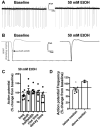Acute ethanol modulation of neurocircuit function in the nucleus of the tractus solitarius
- PMID: 28760662
- PMCID: PMC5788745
- DOI: 10.1016/j.brainresbull.2017.07.019
Acute ethanol modulation of neurocircuit function in the nucleus of the tractus solitarius
Abstract
The nucleus of the tractus solitarius (NTS) is a brain stem region critical to many physiologic processes and has been implicated in addiction to multiple classes of abused drugs, including alcohol (EtOH). That said, the mechanism by which EtOH modulates NTS neurocircuit activity is not well characterized and has yet to be examined utilizing electrophysiologic methods in mouse models of alcohol use disorders. To begin to address this gap in knowledge, we sought to use whole-cell and cell-attached recordings to determine the mechanism of acute EtOH action on GABAergic and glutamatergic neurotransmission, as well as on action potential firing in the NTS of adult male, EtOH naïve mice. Bath application of EtOH (50mM) significantly enhanced the frequency of spontaneous inhibitory postsynaptic current events, while increasing the amplitude of these events in half of the neurons tested. This finding suggests a presynaptic mechanism of EtOH action on GABAergic transmission in the NTS as well as a postsynaptic mechanism in subsets of NTS neurons. EtOH application was further associated with a significant decrease in action potential firing in most, but not all, NTS neurons tested. EtOH induced a small but significant decrease in spontaneous excitatory postsynaptic current frequency, indicating that EtOH may also inhibit NTS glutamatergic signaling to some degree. Intriguingly, in vivo EtOH exposure (4g/kg IP) enhanced c-FOS colocalization with tyrosine hydroxylase via immunohistochemical methods, indicating that NTS norepinephrine neurons may be activated by acute EtOH exposure. Although future work is needed, the current data indicate that acute EtOH may enhance GABAergic signaling in local NTS circuits resulting in disinhibition of NTS norepinephrine neurons. Such a finding has important implications in understanding the role of the NTS in the development of alcoholism.
Keywords: Alcoholism; Electrophysiology; Mechanisms of addiction.
Copyright © 2017 Elsevier Inc. All rights reserved.
Figures




References
-
- Breese GR, Criswell HE, Carta M, Dodson PD, Hanchar HJ, Khisti RT, Mameli M, Ming Z, Morrow AL, Olsen RW, Otis TS, Parsons LH, Penland SN, Roberto M, Siggins GR, Valenzuela CF, Wallner M. Basis of the Gabamimetic Profile of Ethanol. Alcohol Clin Exp Res. 2006;30:731–744. doi: 10.1111/j.0145-6008.2006.00086.x. - DOI - PMC - PubMed
-
- el-Mas MM, Abdel-Rahman AA. Role of NMDA and non-NMDA receptors in the nucleus tractus solitarius in the depressant effect of ethanol on baroreflexes. J Pharmacol Exp Ther. 1993;266:602–10. - PubMed
Publication types
MeSH terms
Substances
Grants and funding
LinkOut - more resources
Full Text Sources
Other Literature Sources
Miscellaneous

